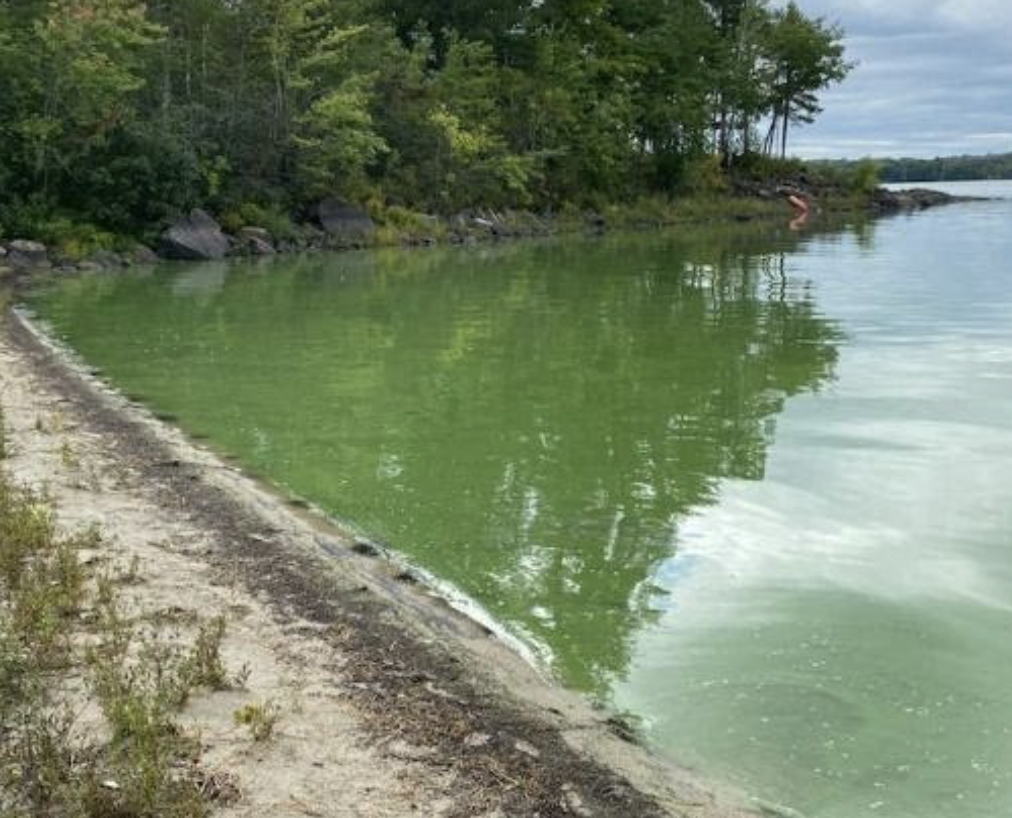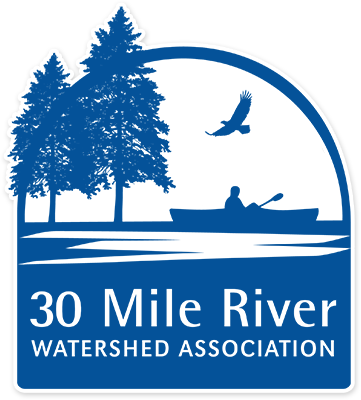In 2021, Androscoggin lake experienced a lake-wide algal bloom, only the second documented on the historical monitoring record spanning the last 52 years. In late August, ALIC and 30 Mile received reports of isolated algal blooms near shorelines. These ephemeral blooms typically concentrate along shorelines and in coves due to wind, and often disperse quickly. Blooms like these are not uncommon on Maine lakes during the summer, especially after rain events.
However, conditions worsened, and by late September water clarity met the criteria for lake-wide bloom status per the Maine DEP definition, with water clarity at the monitoring station below 2 M depth (less than ~6 feet). Clarity remained below or at 2 M through October and November, and the last water clarity reading collected in December showed only a slight improvement with clarity of 2.7 M.
The bloom was caused by cyanobacteria, a type of algae formerly called blue-green algae because dense blooms will turn the water green, or blue-green. Cyanobacteria are a natural and important part of the lake ecosystem, and found in lakes all over the world. However, when stormwater runoff from the land around the lake brings in enough nutrients (phosphorus), and conditions are just right, their population can explode. The result is what we call a “cyanobacteria bloom” or “algal bloom.” The bloom in 2021 is very concerning. However, it’s important to look at the historical monitoring data to better understand the expected conditions in Androscoggin Lake.

Historical Secchi Disk Transparency (SDT) data (1971 – 2021):
Secchi Disk Transparency (SDT) is an indicator of water clarity. A black and white disk is lowered in the water and the reading is taken at the depth at which it is no longer visible. Because it is low cost and easy to measure, SDT is used as a surrogate for measuring algal growth in the lake. SDT data was collected on Androscoggin during 47 of the past 52 years. Readings range from 1.1 M (1999) to 7.3 M (1972) with an average annual reading of 4.3 M.
Androscoggin Lake has a history of reduced water clarity readings during summer months, and has been just below its tipping point for some time. When conditions are just right, it does not take much to push it over the edge. Looking at the distribution of data on record, near-bloom conditions (SDT 2-3 m) were documented during 15 years, but lake-wide bloom conditions (SDT <2 m) just two years, during 1991 and 2021.
What caused the bloom?
Cyanobacteria rely on three things: light, temperature, and nutrients (phosphorus). It is likely that the high air and water temperatures this summer, in addition to the ongoing input of phosphorus as a result of stormwater runoff during summer rain storms, created the perfect environment for an algal bloom.
When it rains, phosphorus enters the lake via stormwater runoff from the land in the surrounding watershed. Phosphorus is a naturally occurring element found in soil, fertilizers, pet and livestock waste, and septic systems among other sources. It is found in very small amounts in the lake, but in very large amounts on land in the watershed surrounding the lake. Every time it rains, water flows over the land and flows downhill into the ditches, streams, and the Lake. When too much phosphorus enters the lake, excess algae growth occurs.
Our current understanding is that the bloom was caused by phosphorus loading from the surrounding watershed. The watershed areas of most concern are the direct watershed surrounding the lake and the Dead River, which this summer may have flowed into the lake instead of into the Androscoggin River due to several unusual factors.
To prevent another algal bloom, we must greatly reduce the phosphorus flowing into the lake. It is so important, now more than ever, that septic systems be functioning properly and pumped regularly. Polluted stormwater runoff needs to be prevented from entering the lake, by every landowner doing their part to be sure that soil, fertilizers, and waste are not washing or leaching into the lake from their property – from roads, driveways, paths, lawns, and more. We need to keep as many trees and shrubs, and as little lawn, growing around the lake as possible.
What you can do RIGHT NOW:
- Become LakeSmart! Contact ALIC’s LakeSmart team to receive a FREE evaluation and learn how you can improve your property for the benefit of Androscoggin Lake: lakesmart@androscogginlake.org, and visit https://www.lakes.me/lakesmart to learn more about this state-wide program.
- Reduce or eliminate soil erosion on your property.
- Establish or improve vegetation on your shoreline. The bigger (wider) your shoreline buffer, the better it is for the Lake. Buffers trap stormwater and phosphorus!
- Stop using fertilizers on your lakefront properties.
- Maintain a healthy septic system, and pump your septic tank regularly.
- Learn more by visiting Maine DEP’s website for Shorefront Property Owners: https://www.maine.gov/dep/land/watershed/camp/index.html
Visit 30 Mile’s Androscoggin bloom page for updates and to learn how you can help.

